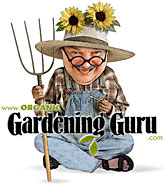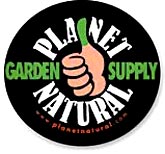Back by popular demand! Part II of the appeal on behalf of Garden Organic, in its effort to save rare and endangered vegetable cultivars. Part I appeared yesterday–technically, the day before yesterday, but I refuse to call it that, since I've only slept once since posting that part. Onwards–
Source: Garden Organic, on-line newsletter, Endangered Seed Appeal, March 2009.
So, you want to know what heirloom vegetables are? Sit down nicely, children, and granny will explain.
Once upon a time back at the green dawn of the world, all seeds were open-pollinated by wind, gravity, or insects. Horticulturalists (once they came along) developed a particular flower or vegetable strain by painstakingly selecting plants that had the look or smell or taste they liked, saving and planting their seeds, and when they sprouted, discarding seedlings and plants that did not have the desired traits and saving seeds from those that did.
The strains that were developed in this way are known as heirloom plants, and at one time there were thousands of them for us to choose from.* Because they were developed through the process described above, in which seeds are saved only from plants that exhibited the bloom color, or fruit size, or cold tolerance aimed at, seeds from heirloom plants can be saved and planted, and they will reliably produce plants like the parent plants. (Cross-pollination from another nearby variety may occur occasionally, but in general heirloom plants run true to type.)
Then, in the grey autumn of the world, (yes, I know I’m mixing my metaphors), scientists experimented with hand-pollinating plants (applying the male pollen from one variety to the female stigma of another) to produce what are known as hybrids. The first tomato hybrid, the “Burpee Hybrid,” came on-line in 1945. Hybrid vegetables have been bred to resist disease, to grow to a uniform size, color, and shape, and to survive the rigors of transportation to distant markets.
Taste, you may note, is not on the list of desired traits, and it shows. Nor was variety a goal; rather, brand recognition, which is necessarily limited to a few select cultivars, became increasingly important. As a result, the number of varieties dwindled, and many heirloom vegetables became endangered and in some cases extinct.
In the British Isles, where hundreds of heirloom varieties have nearly or entirely disappeared, The Heritage Seed Library is dedicated to finding and preserving these many cultivars.
Here’s the exciting part: Seeds for the Library are collected not only from its own gardens, but also from gardeners who act as Seed Guardians, volunteers who raise specific varieties under prescribed conditions and send the seeds back to the Library. The Orphan’s List (Isn’t that a great name?)—the list of varieties needing Guardians—goes out in March, so it should still be possible to participate. If not, there’s always next year.
This is a marvellous way to put gardening expertise to work for a good cause. I like to think of it as preserving the past for the future.
I'm not sure I qualify to participate, here on this side of the water, so I'm hoping to inspire (or bully) some of you folks on the other side to get on the stick and do the necessary.
_______________________________________________
* The term heirloom originally applied only to cultivars that were passed down within a family or community and that had bred true for forty years or more. (Some purists insisted on a hundred years.) More recently, heirloom has become almost synonymous with the term open-pollinated (OP), which applies to plants that may have been developed more recently, some of them (gasp) for commercial use and distribution, but through essentially the same process as that followed to develop traditional heirloom varieties.

 Subscribe to RSS feed
Subscribe to RSS feed



We don’t have something like this in the US? This sounds like such a tremendously cool grass-roots thing to do!
I suppose the closest thing we’ve got in the States is the Seed Savers Exchange. They don’t have seed guardians but they do grow out and preserve seeds at their “Heritage Farm”. They also compile the annual yearbook of seeds offered by members, many of which are heirlooms (the seeds, not the members!). And every few years they publish the Garden Seed Inventory which is a listing of all non-hybrid vegetables offered by mail order vegetable seed companies. That book lists all varieties currently offered by seed companies as well as varieties that have disappeared from the listings (a shocking number). The book is a tool for gardeners who are interested in preserving varieties that are disappearing. And they also have their own seed catalog which offers only a fraction of the varieties that they maintain.
I’ve been growing a number of vegetables that I read about in William Woys Weaver’s book “100 Vegetables and Where They Came From”. The book was published in 2000 and an amazing number of the vegetables described in there are extremely hard to find or not to be found. Sad, I hope somebody is growing them somewhere…
I have been to a lecture today in which the speaker advised that by 2030 we (the World) will need to produce 50% more food with less water and energy than we have now due to the predicted population growth. Therefore one of the ways to do this will be through plant breeding and obviously this included GM crops – not much hope for our heirloom crops.
Excellent information..It reminded me of a pamphlet I ran across many years ago~~’Who Took The Taste Out Of Tomatoes’ (or something very similar). Which talked about breeding tomatoes which could survive long distance traveling but had no taste left! Btw, Seed Savers has fabulous seeds available. gail
Nothing compares to the taste and quality of heirloom plants.I have heirloom tomatoes that knock the socks off everyone I give them to.They now have saved the seeds and have just started their own seedlings for this year.
Wow, a whole crew of new visitors today. I love it. A couple of you might have been here ages and ages past, and if so, please put down my forgetfullness to my increasing age and commensurately decreasing memory capacity.
David I was going to try to answer this question tomorrow, but under the circumstances, I don’t think it’s necessary. Welcome to the Manic.
Welcome to you too, Michelle, you just saved me a whole post. Thank you. Seed Savers, with its 24,000 vegetable varieties (of which 500 are offered publically) offers way more than does Garden Organic, which has a Library of 800 and a catalogue of 200. I’m not sure how long Garden Organic has had a seed program, but Seed Saver’s been at it for 35 years.
Hi, Helen–These short cuts invariable cause problems. Fumigating strawberry fields kills some plant pathogens, but it kills just about everything else, too, leaving plants dependent on artificial fertilizers and on pesticides, since they no longer have the antibiotics produced by bacteria in live soil. Controlling our population is critical. Scary stuff.
And hello to you, Gail–That sounds familiar. Have you heard of the square tomato? Unlike the square needle, it actually exists.
Welcome, Draja. That’s it–I’m coming to France. Brace yourself.
–Kate
kate, I am here trying to remedy the broken link…thanks for the info! gail
Your blogs are addictive and extremely entertaining and informative. Keep up the good work.
Thanks,
Alex
Good luck with it, Gail. This is how we all want to spend our time, right? Fixing broken links.
(In case anyone is wondering, I clicked on Gail’s name after her comment earlier, and when it didn’t take me to her blog, I e-mailed her. I must have a fix-it syndrome.)
manwithaplan–Thank you. Glad to hear it. Following the lead of our tobacco companies, I spike them with nicotine. Welcome to the Manic.
–Kate
Hi Kate, thank you for visiting me at Arnie’s Garden and for the words of encouragement. Not sure what happened with the comments page..one of the mysteries of the computer universe. I saw your rosemary plant and felt for you as it’s the feeling I got when my plants suddenly died. Will be back, you have a very interesting and informative blog! Melinda
Any time, Melinda. My blog may be nice, but your garden beats mine all hollow. I feel like that thing they say about teachers, “Those that can’t do, teach.” Ah well, spring will come even to Montana, one of these days.
–Kate
Hi I would like to start an organic
in tubs plastic pails? I do not know anything about gardening! Thank You!
I love this article / blog about Heirloom. Brandywine are my favorite to grow and then can with them each summer.
WONDERFUL —- LOVE IT!!!
Denise, your best bet is to look up “container gardening” online, and/or to join the Blotanical gardening community (you don’t have to be a blogger) and seek out people who are growing in containers. There are several balcony gardeners out there whose entire gardens are in containers. (You could seek “balcony gardeners” either on Google or at Blotanical.) Good luck!
Bren, I am waiting for the day (year…decade) when I have enough tomatoes to can them. When I reach that point, I’ll be so puffed up you’ll be able to tie a string to me and fly me like a kite.
Kate
As I’m reading your posts, Kate, I am finding so much info. I’ve never heard about before;-) You DO have an interesting blog! Were you ‘gone’ from the blogging world for a while? I started with blotanical in mid-November.
Jan, that’s the nicest thing anyone’s said to me all week. You are welcome to my blog any time. I shall designate a special “Jan” chair that will be reserved for you alone. (I’m not sure how to do this in the virtual universe, but hey–where there’s a will…)
Kate
I think that Seed Savers does do something similar – I’ve often thought it would be really useful to set up a ‘grass roots’ kind of website for those growing heirlooms and sharing seed. (Yeah, like I need something else to do…)
Don’t we all, Pam. I didn’t see anything similar on the Seed Savers site, but I’ll look again. Thanks for weighing in on this one.
–Kate
I never knew there was such a thing as “Seed Guardians” or an “Orphan’s List” but I am interested in taste! I’m glad (for that reason alone) there is an effort underway to save the heirlooms.
It is encouraging, isn’t it, Kathleen.
–Kate